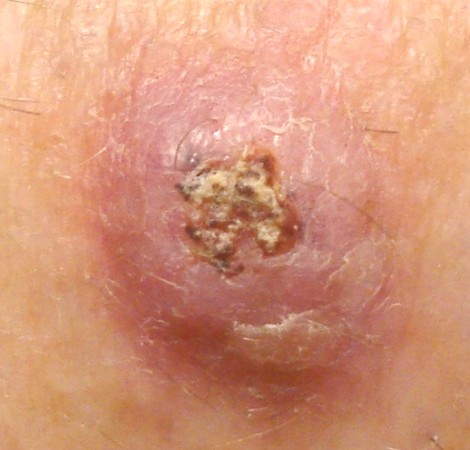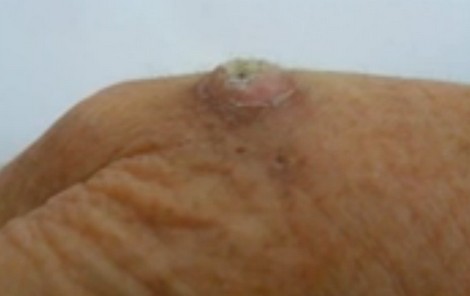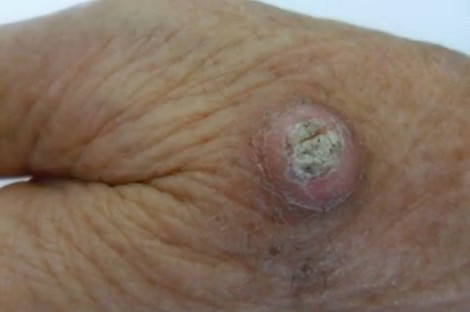Keratoacanthomas are a type of skin cancer marked by rapid formation of dome-shaped bumps on the skin. Often referred to in its abbreviated form ‘KA’, keratoacanthoma typically affects middle-aged and older adults with long-term exposure to the UV rays of sunlight, though it can also occur in people of all age groups.
Medical experts are of the opinion that keratoacanthoma is a type of squamous cell carcinoma; they are however less aggressive in comparison. Most instances result in limited damage to the skin. Some affected individuals may experience the more severe forms along with the added risk of the cancer spreading to the lymph nodes.
Symptoms of keratoacanthoma
A few major signs and symptoms accompanying keratoacanthomas are mentioned below:
- Keratoacanthomas normally erupt on the skin as small lesions and are similar to pimples in appearance. The lesions consist of keratin, a major protein component present in hair, skin, and nails.
- Once it begins, a keratoacanthoma will grow rapidly for around two to six weeks, eventually forming into a skin-colored, dome-shaped lump with a tiny trough in the center. Its size may vary; it may be as small as one cm or as large as three 3 cm.
- Most patients suffer from keratoacanthomas on the middle area of the face and back section of the hands as well as on the forearms, scalp, and ears. The lower areas of the legs may also sometimes develop keratoacanthomas, more so in women.
- Keratoacanthomas are usually not painful. Some patients may suffer from discomfort and itching. Depending on the location of these skin lesions, the functioning of the affected body part may be impaired.
- In rare cases, keratoacanthomas can be a symptom of the underlying presence of some other deadlier disease.
Causes
- Keratoacanthomas typically occur in fair-skinned older individuals with a history of contact with sunlight for many years.
The below listed risk factors can pose increased susceptibility to formation of keratoacanthomas:
- People over the age of 50 years are more vulnerable than others
- Increased contact with sunlight or other kinds of UV light increases the risk.
- Individuals with fair skin, light hair, and light-hued eyes are at greater risk.
- Men are more prone to develop keratoacanthomas than women.
- Intake of immunosuppressant drugs for long periods of time, as in the case of post organ transplantation care, can also pose increased risk.
- Infection with HPV and other particular strains of the wart virus.
- Undergoing radiation therapy for treating cancer of the internal organs.
- Prolonged cases of ulcers; exposure to tar and other such chemicals and toxins; chronic scarring as in the case of gasoline burns; and a pre-existing or old case of skin cancer are other factors that can increase the vulnerability to developing keratoacanthomas.
Treatment
Most untreated cases of keratoacanthomas resolve suddenly on their own in around 6 months. All that is left is a sunken scar mark on the affected skin site.
It is however vital for all patients to consult a doctor for evaluation and treatment, if recommended. This is because keratoacanthomas can cause significant harm to the skin’s upper layers as well as to the tissues occurring under the epidermis.The ugly nature of the skin condition may cause stress, embarrassment, low self-esteem, and other psychological issues in patients. Another reason for prompt diagnosis and relevant treatment is the fact that certain rare forms of keratoacanthomas can metastasize to the deeper layers of the skin, and even to the lymph nodes.
It may also be noted that any and all kinds of abnormal bumps on skin need to be checked by a doctor. It is especially vital if such bumps are constantly exposed to the sun; do not heal on their own; show changes in shape, color, or size; bleed slightly or profusely; or elicit tenderness, soreness, or itchiness.
After a physician has diagnosed an abnormal bump on the skin to be a case of keratoacanthomas; then he/she may opt for the below listed treatment options:
- Surgery: The keratoacanthoma bumps are surgically cut out, and then the site is sutured and bandaged.
- Mohs micrographic surgery: This unique surgical procedure involves removal of layers of affected skin till the entire skin lesion is removed. Doctors use this procedure for removing keratoacanthomas in sensitive areas like the nose, lips, ears, and hands.
- Cryosurgery: In this, the keratoacanthoma lesions are frozen with liquid nitrogen and thus destroyed.
- Chemotherapy and radiation therapy: These treatment options are used to get rid of cancerous or malignant cases of keratoacanthomas.
It is important for patients to go for regular checkups post treatment so as to prevent any relapse. Doctors may also recommend the below listed self-care guidelines to prevent the development of new cases of keratoacanthomas.
- Avoid prolonged exposure to all kinds of UV light, including artificial tanning equipment, sunlight, etc.
- Use sunscreen with a minimum SPF of 30 before venturing outdoors. Also use other protective gear like hats, sunglasses, long-sleeved shirts, etc.
- The sun is at its harshest between 10 in the morning and 3 in the afternoon. It is best to try and stay indoors during this period.
Keratoacanthoma Pictures





After examine a couple of of the blog posts in your website now, and I actually like your manner of blogging. I bookmarked it to my bookmark web site listing and will likely be checking back soon. Pls take a look at my web page as nicely and let me know what you think.
Hello, I simply enjoy scrapbooking, its so entertaining!